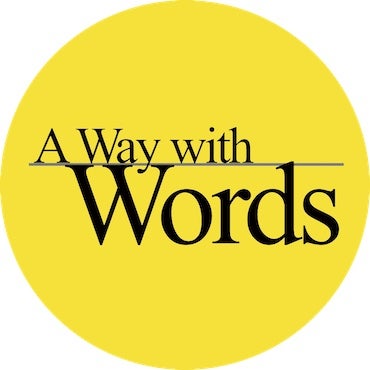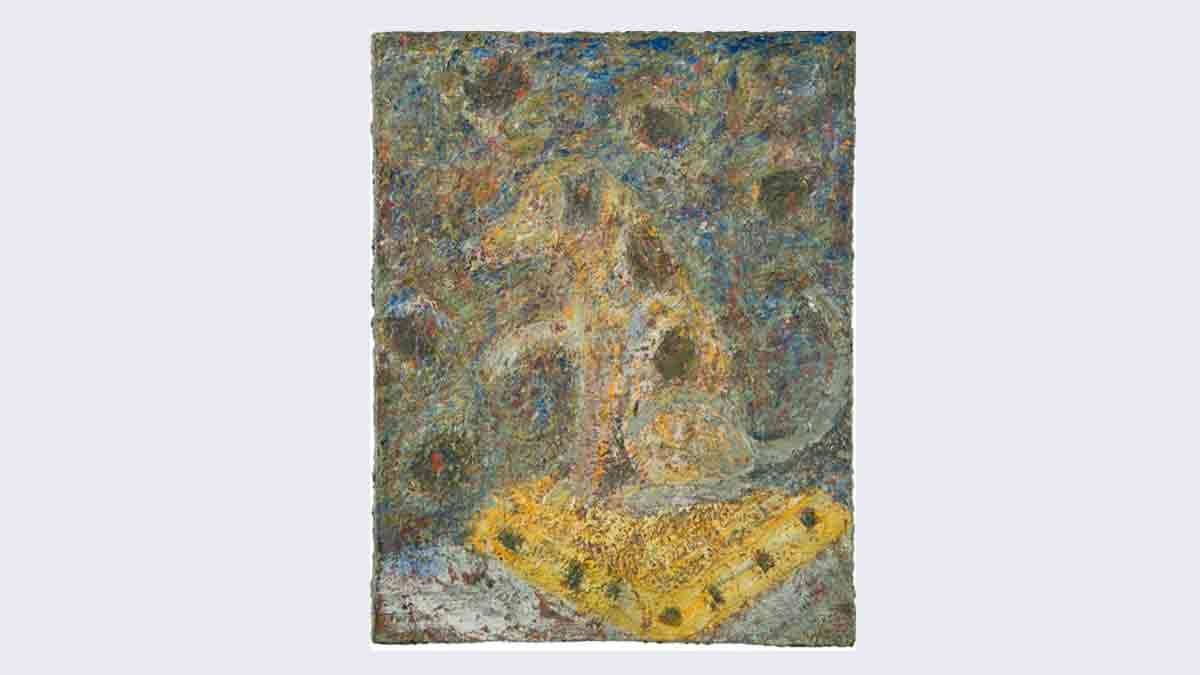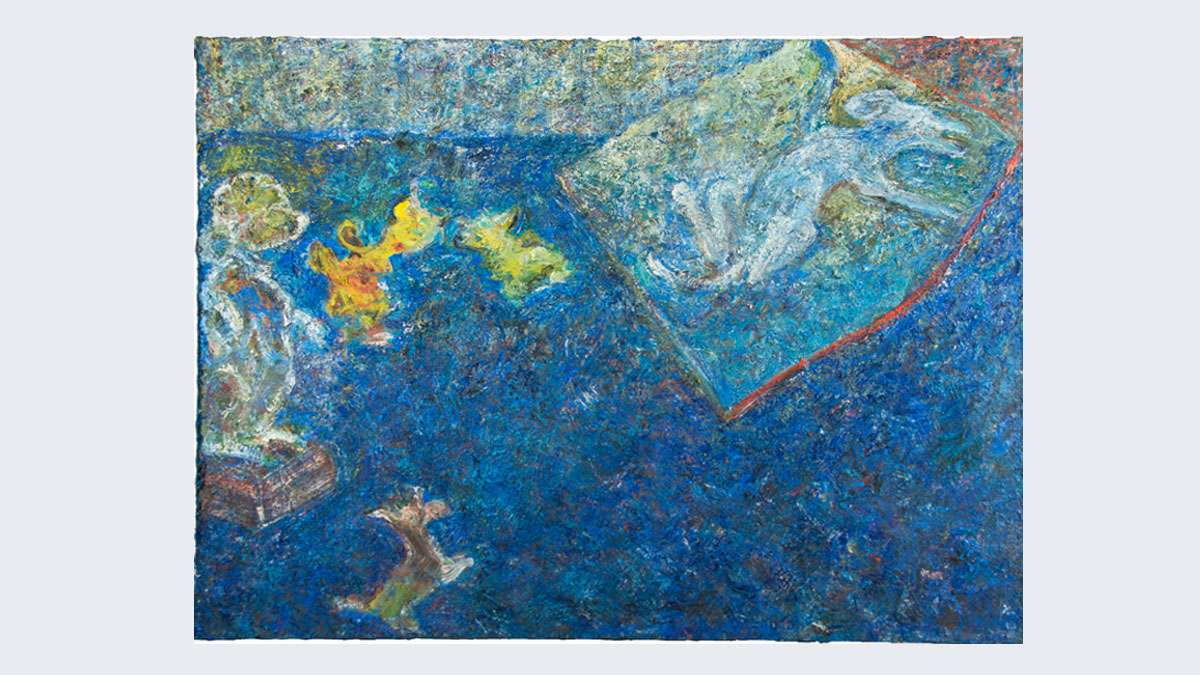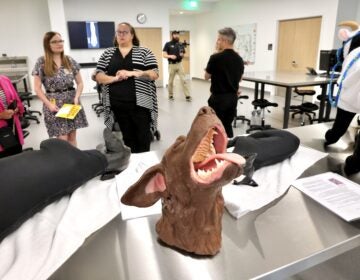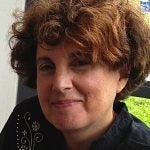Rider University Gallery features the work of Trenton artist Tracey Jones
There’s a fine line between abstract art and a painting of a landscape, says abstract artist Tracey Jones. Sometimes it’s just a horizontal line. Jones’s own canvases run the gamut, from textured surfaces to lines amid pattern and color that suggest animals, flooring, picnic blankets and flags. And as abstract as she can be, as a teacher, she instructs her students to draw from life—either a model or a still life—as she was taught long ago. A retrospective of Jones’s abstract paintings is on view at the Gallery at Rider University through October 16.
As we climb the three flights to her studio in the Mill Hill neighborhood of Trenton, the dogs—Sam and Tommy— vocalize their wish to come along but are kept out with a gate. The cats are welcome, alongside enormous canvases of splattered paint leaning against walls. Even the floor, with its colorful drippings, is a work of art. One cat is content in a basket, another stretches out on newspaper, and a third basks in the sun.
Using brushes from the hardware store, Jones applies and scrapes paint, creating pitted surfaces in purples, blues, greens and pinks. She layers on a lot of paint. This can be costly, and so she buys her paint from a colleague in Albany, N.Y., who manufactures it. When living in Manhattan, Jones and her husband, Geoffrey Dorfman, belonged to a community of abstract artists who made their own paint using machines that had belonged to noted Abstract Expressionist Milton Resnick.
“We made it by the gallons,” recounts Jones. “It was like a paint co-op. You could buy the pigment and linseed oil and we used a giant mixer and press. It was fun working together but incredibly messy. We had to cover ourselves with masks and Vaseline.”
In his 1963 novel “Cat’s Cradle,” author Kurt Vonnegut introduced the concept of a duprass: a loving couple linked in a cosmically significant manner who work together for a greater purpose. Jones and Dorfman could be described as such a couple. Their memories work collectively so that if, for example, Jones can’t remember the name of one of her paintings, Dorfman can summon it up.
The two abstract painters, both New York natives, met while students at Cooper Union, went to Syracuse University for their master’s degrees and both teach at the College of Staten Island, City University. Dorfman has a studio on the second floor of their Mill Hill home, Jones on the third floor, and they order paint and canvas together. Dorfman had a solo exhibition at the Gallery at Rider University just three years ago.
While Jones and Dorfman were at Syracuse, Milton Resnick came as a visiting professor. Meeting and getting to know him was an experience that transformed their lives. His lectures were compared to punk performances with attitude.
It could also be said that Resnick was part of a duprass—his wife Pat Passlof was another abstract painter. In fact Jones, Dorfman, Resnick and Passlof could make up what Vonnegut termed a karass—a group of people linked in a cosmically significant manner. In this karass, the greater purpose they were all serving was 1970s Abstract Expressionism in New York.
Passlof, too, taught at the College of Staten Island. In an end-of-life decision, Resnick took his life in 2004, and in 2011, when Passlof died, both Jones and Dorfman became trustees of the Milton Resnick and Pat Passlof Foundation. Dorfman, who is also a concert pianist and composer, wrote a book, “Out of the Picture: Milton Resnick and the New York School,” and Jones served as the executor of Paslof’s estate.
The Foundation is based in a repurposed synagogue that Resnick used as his studio at 87 Eldridge St., just a stone’s throw from Manhattan’s New Museum and Tenement Museum, and will exhibit works by Resnick, Passlof and other painters working in or influenced by Abstract Expressionism; host poetry readings, performances and lectures; and house an archive of Resnick and Passlof’s papers, available to scholars. The building itself will be a draw, with its rich architectural history and rose windows, when it opens in late 2017.
One of the advantages of being in a duprass is the support each artist offers the other. “We bring out the best in each other and offer each other feedback,” says Jones. “Even if negative it keeps you on your toes.”
________________________________________________________________________
The Artful Blogger is written by Ilene Dube and offers a look inside the art world of the greater Princeton area. Ilene Dube is an award-winning arts writer and editor, as well as an artist, curator and activist for the arts.
WHYY is your source for fact-based, in-depth journalism and information. As a nonprofit organization, we rely on financial support from readers like you. Please give today.
